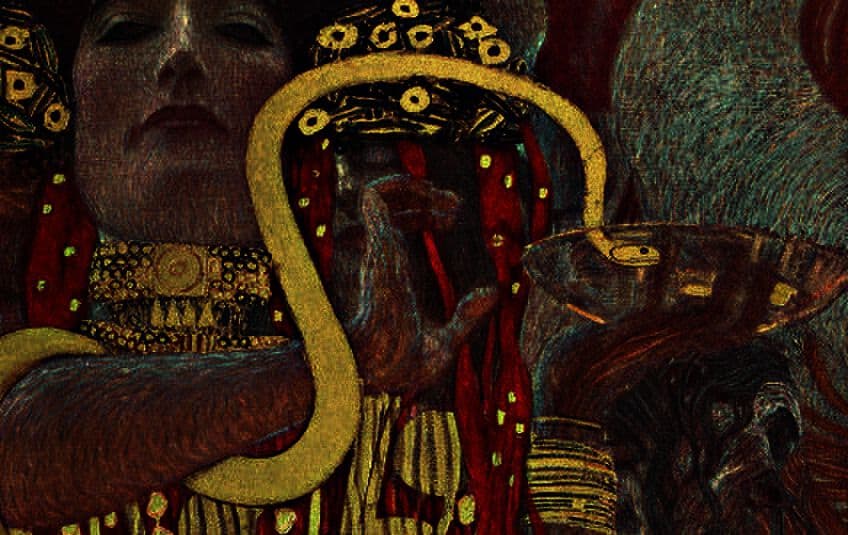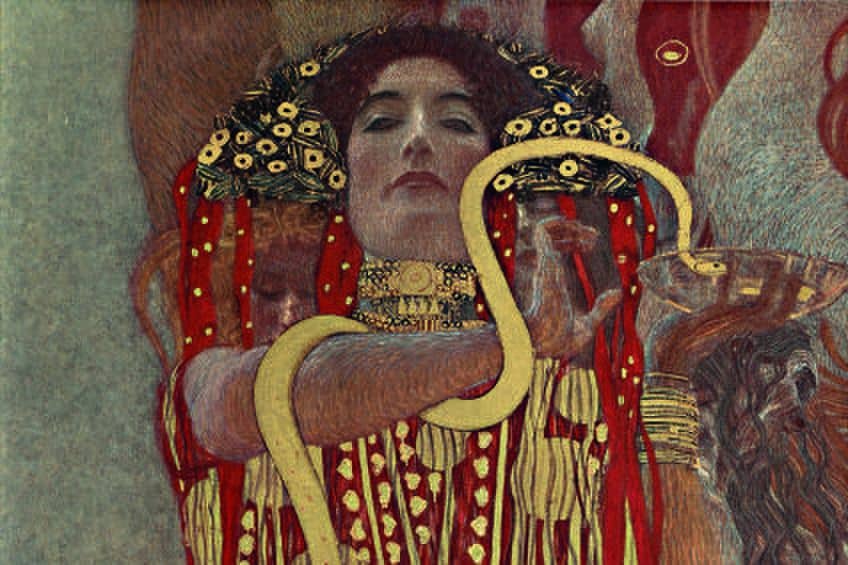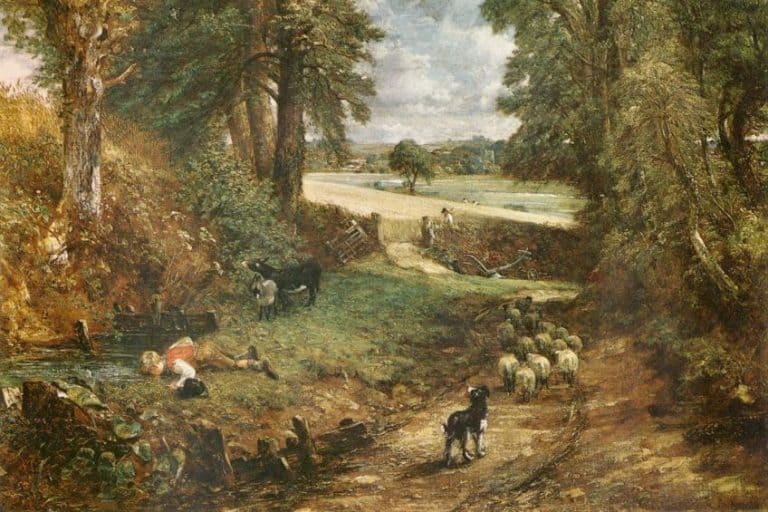“Hygeia” by Gustav Klimt – A Contextual Painting Analysis
Gustav Klimt’s Hygeia stands as a captivating testament to the artist’s profound exploration of human form and symbolism within the realm of Art Nouveau. Completed in 1900, during the apex of Klimt’s Golden Phase, this masterpiece portrays Hygeia, the Greek goddess of health and cleanliness, with mesmerizing detail and symbolism. Klimt’s intricate use of gold leaf, intricate patterns, and sinuous lines infuses the artwork with an ethereal quality, inviting viewers into a realm where myth, beauty, and the human condition intertwine. Through Hygeia, Klimt not only celebrates the ideals of health and vitality but also offers a profound commentary on the fragility and transcendence of life itself, making it a quintessential piece in the artist’s oeuvre and a cornerstone of Art Nouveau aesthetics.
Key Takeaways
- Hygeia is part of Gustav Klimt’s Medicine, a painting commissioned for the University of Vienna.
- Klimt’s Faculty paintings, including Hygeia, were controversial due to their innovative and symbolic approach.
- The legacy of Hygeia in Klimt’s oeuvre is significant in terms of its impact on art and its enduring influence.
Historical Context and Creation
| Artist | Gustav Klimt (1862 – 1918) |
| Date Created | 1907 – 1908 |
| Medium | Oil on canvas |
| Genre | Art Nouveau |
| Period/Movement | Vienna Secession |
| Dimensions (cm) | 180 x 90 |
| Series/Versions | N/A |
| Where Is It Housed? | Belvedere Museum, Vienna, Austria |
| What It Is Worth | Estimated to be invaluable, given Klimt’s significance in art history. |
Gustav Klimt’s Hygeia is a significant detail from the larger painting Medicine, one of Klimt’s most controversial and acclaimed works. Commissioned for the Great Hall ceiling of the University of Vienna, it formed part of a series known as the Faculty paintings. This series was meant to embody the themes of the university faculties, with Medicine representing the field of medical science. Klimt’s representation diverged from classical depiction, portraying a complex, interwoven scene of life, death, and the human condition.

Within Medicine, Hygeia stands out as a focal element; she is the mythological goddess of health, cleanliness, and hygiene, traditionally associated with the prevention of sickness and the continuation of good health. In Klimt’s interpretation, Hygeia is presented alongside a snake and the cup of Lethe, against a backdrop of ethereal figures and a skeleton, which alludes to death. Klimt’s work was met with both acclaim and criticism, as his avant-garde symbolism and sensual portrayal in the context of medicine were considered provocative at the time.
Cultural and Biographical Influences
Gustav Klimt, a central figure of the Secession movement, sought to challenge the status quo of Viennese art through innovative themes and styles. The Hygeia forms part of a larger commission for the University of Vienna’s Great Hall and is a direct product of its cultural milieu. The painting is anchored in a classic theme, featuring the Greek mythological figure Hygeia, the goddess of health, cleanliness, and sanitation. However, Klimt’s interpretation of this mythological figure is steeped in the iconoclastic spirit of the Secession, which aimed at breaking from the academic constraints and embracing a more liberated, artistic expression. In creating Hygeia, Klimt married his deep understanding of classical subjects with an artistic language that resonated with modernist sensibilities.
The influence of his architectural background is also palpable in the structural precision and composition of the piece.
Critical Reception and Interpretation
Upon its presentation, the Hygeia part of the University of Vienna Ceiling Paintings stirred a mix of admiration and controversy. Debates ensued not only about the provocative depiction of nude forms but also about the suitability of such a bold, modernist interpretation within an academic institution. Some critics lambasted the work for what they perceived as a deviation from the decorum expected in a university setting.

Despite the contentious reception, Hygeia garnered significant attention, marking an important point in Klimt’s career. This painting was also displayed in the Secession Exhibition, serving as a testament to Klimt’s growing prominence and the Secessionists’ challenge to established artistic conventions. The figure of Hygeia herself, at once firmly rooted in tradition and boldly reimagined, symbolizes not only the timeless relevance of classical themes.
It also symbolizes the inexorable march of artistic innovation.
The Faculty Paintings
The Faculty paintings, a series conceived by Gustav Klimt, were intended for the University of Vienna’s Great Hall. These contentious works, including Medicine, portrayed complex themes of human existence and knowledge that generated public debate.

Representation of Medicine and Healing
Hygeia, a key element from the Medicine panel, displays Klimt’s interpretation of health and its governance by the mythical. Hygeia, the Greek goddess of health, is depicted at the bottom of this work. She embodies the essence of healing and cleanliness, symbolized by her presence alongside traditional medical symbols such as the snake and the cup of Lethe, a reference to oblivion and presumably the relief from suffering. This facet of the painting emphasized the interconnection between life, death, and the continuous cycle of health and disease.
The overarching narrative forged a visual language that challenged viewers’ perceptions of medicine by intertwining mortality and the divine protector of health.
Formal Analysis
This section scrutinizes the visual elements and symbolic motifs in Gustav Klimt’s Hygeia, with particular attention to the subject matter, color utilization, and layered symbolism.

Subject Matter
In Hygeia, Klimt tackles the goddess of health from Greek mythology. The central figure is associated with wellness, as underscored by the snake often symbolic of medicine, suggesting her identity directly links to the healing arts.
Adjacent to her, a skeleton and an array of other figures contribute to an allegory of life and death.

Use of Color
In Hygeia, Klimt orchestrates a symphony of contrasts through his nuanced palette, delineating the stark boundaries between life and mortality. Ethereal flesh tones bestowed upon the figures exude vitality, while the stark whites and greys of the skeleton accentuate the inevitability of death. Against a backdrop of muted colors, Klimt sets a tone of somber reflection, inviting viewers to contemplate the delicate balance between existence and transience. Through his meticulous use of color, Klimt transcends the canvas, imbuing Hygeia with a timeless dialogue on the fragility and resilience of the human condition.
The use of gold, common in Klimt’s works, appears more subdued in this painting, serving to illuminate specific features rather than dominate the piece.

Symbolism
In Hygeia, Gustav Klimt weaves a tapestry of intricate symbolism, enriching the composition with layers of meaning. The snake, traditionally associated with medicine, coils around the Cup of Lethe, embodying the dual nature of healing and oblivion. The skeleton, a potent symbol of death, looms prominently, underscoring the inescapable presence of mortality. Meanwhile, the column of light rises, suggesting a transcendental journey or perhaps the eternal struggle between life and death.
Through these symbolic elements, Hygeia transcends mere mythological representation, serving as a profound exploration of life’s fragility, the pursuit of health, and the inevitability of mortality within Klimt’s oeuvre.

Legacy and Impact of Hygeia
Gustav Klimt’s Hygeia has left a profound mark in the realm of art history, intertwining elements of mythology with bold explorations of the female form. Its journey has been marred by controversies, faced threats of censorship, and ultimately, its original form has suffered a tragic fate. Hygeia, as part of Klimt’s University of Vienna ceiling paintings, was a testament to his unique approach, embedding philosophy, mythology, and healing arts within the visual narrative. Highlighting the figure of Hygeia, the goddess of health, the artwork incorporated a snake, often associated with healing, and imagery suggestive of death and the River of Life, reflecting a cycle of existence.
The integration of nude figures and female form was typical of Klimt’s celebrated style.
Controversies and Censorship
Post its unveiling at the Secession Exhibition, Hygeia faced public scrutiny. Critics used terms like pornographic and perverted to censure Klimt’s artworks, expressing discontent over the sensual depiction of nude female figures and the raw power of the female form. Despite the uproar, Klimt championed creative freedom, unwilling to let go of his artistic vision despite the resistance from conservative factions within Vienna.

Preservation and Destruction
Tragically, the original painting of Hygeia, along with other Klimt masterpieces, was destroyed by retreating SS forces who set fire to Schloss Immendorf in 1945, an act that obliterated a significant portion of Klimt’s oeuvre. Although Hygeia is lost to time, its impact endures in the art world.
Its decorations and thematic choices continue to influence modern portrayals of the female form and the embodiment of complex themes such as life and morality in art.
Influence on Contemporary Art and Popular Culture
Gustav Klimt’s impact on contemporary art and popular culture is notable, especially in how the figure of Hygeia has inspired various representations of women and the female form. His painting, Hygeia, part of his larger work Medicine, continues to influence artists with its unique style and bold thematic content. In his artistic representation within Hygeia, Gustav Klimt encapsulates his thematic exploration and stylistic innovation.
The figure of Hygeia, a recurring motif in Klimt’s repertoire, emerges as a potent symbol of health and vitality, embodying the artist’s reverence for life.
The nude figures, rendered with revolutionary boldness, reflect Klimt’s profound celebration of the natural form, challenging conventional artistic norms. Particularly, his portrayal of women as divine and enigmatic beings elicits both reverence and critique from artists and feminists, sparking profound discussions about beauty, power, and representation in art. Through these elements, Hygeia not only exemplifies Klimt’s artistic mastery but also invites contemplation on the complexities of human existence and the role of art in shaping perceptions of femininity and the body.

Many contemporary artists cite the aesthetic of Klimt’s work, specifically his seductive Byzantine and Art Nouveau influence, shaping approaches to portraying mythological and symbolic figures. The intricate details and thematic exploration in his paintings stimulate modern artistic dialogues around life, death, and the continuum between the two.
In popular culture, reproductions of Klimt’s art, including imagery of Hygeia, appear on an array of merchandise.
Exhibitions of his work, as well as literary and cinematic references, reiterate his lasting cultural significance. They showcase how his artistic vision has been absorbed into the collective consciousness, often manifesting in the homage and reinterpretation of his iconic style and themes.
Gustav Klimt’s Hygeia stands as a testament to the artist’s unparalleled ability to infuse mythological themes with intricate symbolism and breathtaking beauty. Through his masterful use of gold leaf and intricate patterns, Klimt transforms the depiction of the Greek goddess of health and cleanliness into a mesmerizing exploration of human vitality and the transient nature of existence. Hygeia not only exemplifies Klimt’s mastery of the Art Nouveau style but also invites viewers to ponder the interconnectedness of life, beauty, and mortality. As one gazes upon this iconic artwork, they are transported into a world where the divine and the human converge, leaving an indelible mark on the annals of art history and inspiring generations to come.
Frequently Asked Questions
What Significant Themes Are Depicted in Gustav Klimt’s Medicine?
Gustav Klimt’s Medicine displays themes of life, death, and the inexorable passage of time. The figure of Hygeia, the mythological daughter of the god of medicine, appeared at the painting’s bottom, symbolizing health and cleanliness. Death is represented by a skeleton, introducing a darker theme to contrast with the life-affirming symbol of Hygeia.
How Is Philosophy Reflective of Gustav Klimt’s Personal Worldview?
Philosophy, one of Klimt’s renowned University of Vienna ceiling paintings, showcases his personal view on the depth of human knowledge and the mystery of existence. The painting elicits a dialogue between the limitations of human understanding and the natural quest for meaning, thus reflecting Klimt’s intrigue with intellectual pursuits and the complexities of the human mind.
Isabella studied at the University of Cape Town in South Africa and graduated with a Bachelor of Arts majoring in English Literature & Language and Psychology. Throughout her undergraduate years, she took Art History as an additional subject and absolutely loved it. Building on from her art history knowledge that began in high school, art has always been a particular area of fascination for her. From learning about artworks previously unknown to her, or sharpening her existing understanding of specific works, the ability to continue learning within this interesting sphere excites her greatly.
Her focal points of interest in art history encompass profiling specific artists and art movements, as it is these areas where she is able to really dig deep into the rich narrative of the art world. Additionally, she particularly enjoys exploring the different artistic styles of the 20th century, as well as the important impact that female artists have had on the development of art history.
Learn more about Isabella Meyer and the Art in Context Team.
Cite this Article
Isabella, Meyer, ““Hygeia” by Gustav Klimt – A Contextual Painting Analysis.” Art in Context. February 23, 2024. URL: https://artincontext.org/hygeia-by-gustav-klimt/
Meyer, I. (2024, 23 February). “Hygeia” by Gustav Klimt – A Contextual Painting Analysis. Art in Context. https://artincontext.org/hygeia-by-gustav-klimt/
Meyer, Isabella. ““Hygeia” by Gustav Klimt – A Contextual Painting Analysis.” Art in Context, February 23, 2024. https://artincontext.org/hygeia-by-gustav-klimt/.











